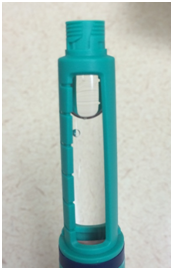Challenges of Switching to Insulin Pens
What’s wrong with this insulin pen in Figure 1? The large air bubble at the top is an indicator that the cartridge was incorrectly used as a vial to withdraw insulin.
Insulin pen devices are preferred to the traditional vial and syringe delivery by patients, physicians, and nurses across most settings.1 Pen devices have several advantages over insulin vials, including ease of use, dosing accuracy, increased safety via less risk for needle sticks, and potential cost savings.2 Due to these benefits, insulin pen use in the senior care setting has increased.
Most insulin is available in both a vial and pen, however, newer formulations such as Toujeo® are only available via a pen device. Although insulin pens are marketed as easier to use and more accurate than traditional syringe/vial administration, education and training is still required. Your AlixaRx Clinical Pharmacist is a great resource to educate patients and other health care providers on the proper use of insulin pens. Often this includes education about key concepts that are commonly missed or forgotten. Listed below are some common errors in administration noted at skilled nursing facilities:
- Failing to prime the pen or perform a test dose
- Not holding down the button or plunger for the appropriate time (refer to individual package inserts for complete administration details)
- Not swabbing the pen with alcohol prior to needle attachment
- Safety needles must be properly attached to the pen prior to administration. If not, the needle will not puncture the pen device and nursing may report the pen is “stuck” or “isn’t working”.
- Using the pen device as a vial and withdrawing insulin with an insulin syringe (Figure 1)
Your AlixaRx Clinical Pharmacist can provide in-servicing and education to help prepare nursing staff. All pen manufacturers have training aids and brochures available for additional education. Scheduled follow up training is essential to educate new staff and remind current staff of the proper technique. Failing to prime the pen, removing insulin from the pen device, or not realizing the safety needle has engaged can result in dosing errors and significant risk for patients. Failing to use aseptic technique or entering the pen via a syringe for insulin removal can result in infection control issues. Any potential error in administration resulting in the pen device being damaged, or the incorrect dose being administered, can hamper the clinician’s ability to make appropriate dosage adjustments. This is an opportunity for collaboration with facility staff, prescribers, and your AlixaRx Clinical Pharmacist to improve patient outcomes.
The insulin pen in Figure 1 was one of several noted at a skilled nursing facility. During a follow up in-service, it was discovered that a nurse was afraid patients were not getting the proper dose of insulin when using the insulin pen. In an effort to ensure patients received the correct dose of insulin, this nurse was utilizing the insulin pen as a vial. What the nurse did not realize was this practice resulted in dosing errors, increased infection risk, and damage to the pen device.
Challenge yourself at the next opportunity you have with a resident or other healthcare provider utilizing insulin pens. Become an expert on insulin pen technique and your residents can experience positive outcomes and enhanced diabetic control.
References: 1. Peyrot M, Rubin RR. Physician perception, recommendation and use of insulin pens for patients with type 2 diabetes. Curr Med Res Opin 2008; 24: 2413–2422. 2. Shaghouli AA, Shah BR. The prescription of insulin pen devices versus syringes for older people with diabetes. Diabetes Technol Ther. 2009;11(7):439-442.
This article was originally published in our monthly issue of From the Front Lines – a monthly publication that shares best practices and medication-related challenges faced by “front line” staff in long-term care and post-acute (LTCPAC) facilities.





